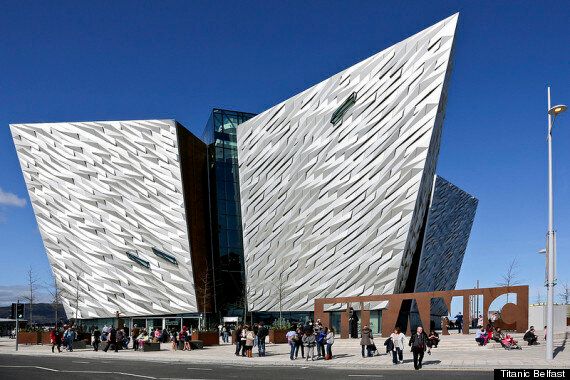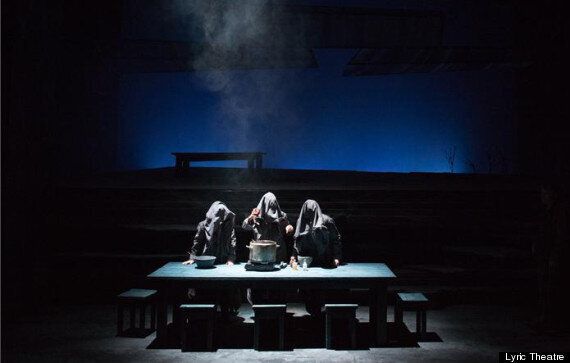During the Troubles, Belfast’s segregated Catholic and Protestant communities painted murals on houses and the imposing peace walls of their politically-charged neighbourhoods.
While for most of the community the 1998 Good Friday Agreement marked the end of this era, the art has remained. The murals are no longer just a statement of political allegiance, they help form an emerging identity for the city as a hive of art and culture, rather than the heartland of a civil war.
Earlier this year, Belfast celebrated the Titanic centenary by opening a museum dedicated to the fated ship, which was built in the city. As a museum, the Titanic Belfast is as resplendent and pioneering as the White Star liners themselves once were.

Designed by CivicArts, the Titanic Museum stands on the old shipyard
A spiky interpretation of a ship’s bows, the museum looks out over the now-concreted slipways where Titanic and her sister ship Olympic were launched into the coastal waters beyond. On a bright, sunny day, the former Harland and Wolff shipyard is now a sight to behold.
As museums go, it’s a whopper at 12,000 square metres, and has integrated technology and visitor interaction like none I’ve ever experienced. While considerable focus is on Belfast’s shipbuilding past and the construction of Titanic (including a ride around an immersive shipyard), the real highlights are the 360 degree video journey through the Titanic’s class-divided floors and the cleanly presented data of the ship’s death toll and its aftermath.

The interactive galleries at Titanic Belfast recreate the night the ship sank
An impressive auditorium shows films about the modern-day underwater search for Titanic’s remnants, and outside, you're given the opportunity to stand on the ground where the ship once stood to be waved off by crowds of thousands. You can see how the minds behind Titanic Belfast have deliberately made a play for revisits: it’s just too big to conquer in a day.
Onwards to the Lyric Theatre. At the admission of Gary Potter from Place, who aim to positively influence Northern Irish architecture, Belfast hasn’t been known for it’s building prowess over the last half century. The Theatre is a rare exception; founded in its current location on W.B Yeat’s birthday in 1965, it had a multi-million pound revamp and re-opened three times larger in 2011 at the hands of Dublin architects O’Donnell & Tuomey.
Now the theatre continues to hold onto its legacy for putting on shows from dramatists rarely shown in bigger theatres, launching the careers of the likes of Liam Neeson, now a theatre patron, and Kenneth Branagh.

Macbeth at the newly-refurbished Lyric Theatre
Macbeth is on at the Lyric while we’re in town, and director Lynne Parker’s version is contemporary, raw, and so Irish than any mentions of Scotland seem incongruous. Diana Ennis’s set and costume design is cleverly done, with a central set of uneven stone steps, lighting panels which recreate the aurora and tiered stage, gravelled to create perfect tension. The witches’ forboding presence is added to by the oversized hooded parkas they are cloaked in, although a similar casual approach to the play’s royalty isn’t quite as effective.
The Lyric and Titanic are purpose-built for Belfast’s blossoming cultural scene - but plenty of what goes on in the city happens under canvas, in restored or reclaimed Victorian buildings or pub back rooms in the form of seemingly never-ending festivals. We arrive in the midst of the 50th Belfast Festival at Queen’s, where the city’s historic university plays host to a wide variety of comedy, dance, theatre, music, film and art. But as soon as that ends, Belfast Music Week begins. There is, we are told, always something going on - and it’s easy to believe.
Even without the infrastructure of curated events, a trip into Belfast’s entries - the close-knit alleyways which once served the city’s burgeoning industry - will take you to its oldest pubs, scenes of plenty of live music. The Duke Of York is known for being the site of Snow Patrol’s first gig, but its the murals on its neighbouring walls which are a greater reflection of the site’s musical significance.
Amongst the Dali reproductions, Radio 1 DJ John Peel and the Undertones are remembered on Commercial Court’s walls, for it was on the neighbouring Donegall Street where the Derry punk band recorded Teenage Kicks - the only song Peel played twice in a row.
They're impressive, but it is those murals that literally paint the city's political colours to the mast that are the most striking. The segregated Catholic and Protestant neighbourhoods - divided by a 25ft high peace wall - have been a living, breathing gallery all throughout Ireland's tumultuous recent history.
On the Shankill Road side the community are determined to turn the wall into the world's longest canvas for street art. The murals on the Catholic Falls Road act as shrines to the political prisoners and hunger strikers who fought and died for their beliefs.
Such reminders are all over the city, but thanks to an innovative approach to art and culture, visitors to Belfast can now enjoy the city's present and future rather than dwell on its past.